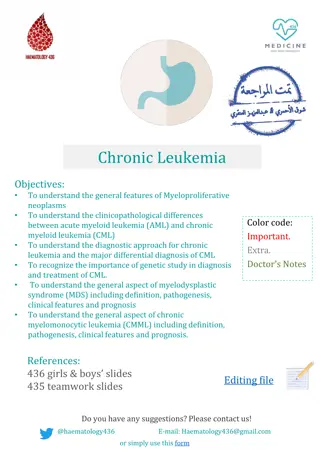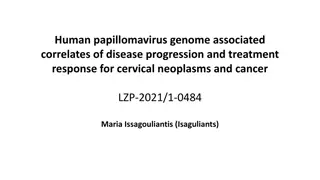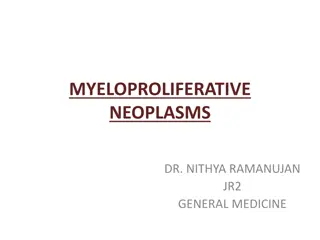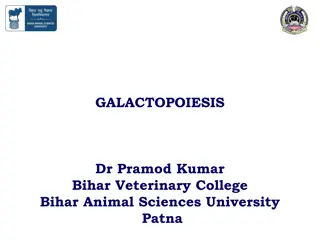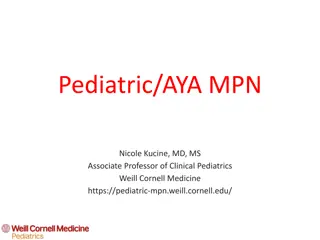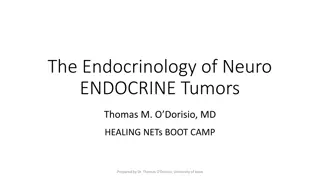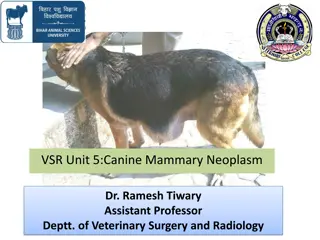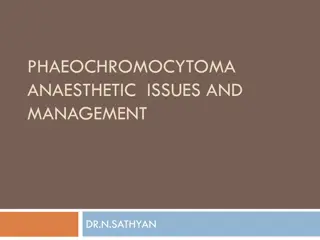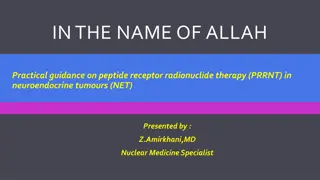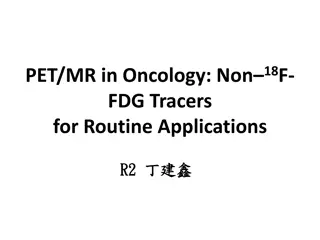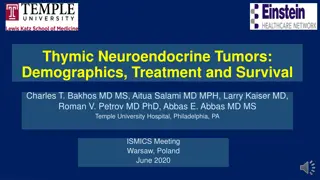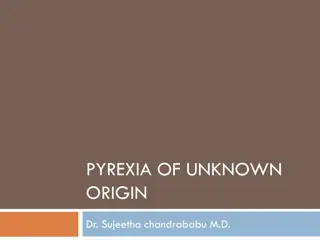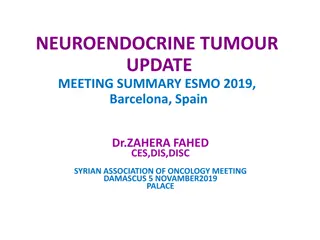Overview of Chronic Leukemia and Myeloproliferative Neoplasms
This comprehensive guide covers the general features, diagnostic approach, and clinicopathological variances between acute myeloid leukemia (AML) and chronic myeloid leukemia (CML), along with insights into myelodysplastic syndrome (MDS) and chronic myelomonocytic leukemia (CMML). It emphasizes the
1 views • 9 slides
Investigating Human Papillomavirus Genomes in Cervical Neoplasms
This project focuses on studying the Human Papillomavirus (HPV) genome's association with disease progression and treatment response in cervical neoplasms and cancer. The research aims to genotype high-risk HPVs in healthy and diseased cervix, identify prevalent genotypes, detect genotype drift, cha
1 views • 13 slides
Understanding Electroconvulsive Therapy (ECT) for Psychiatric Treatment
Electroconvulsive Therapy (ECT), also known as electroshock, is a psychiatric treatment that induces seizures in anesthetized patients for therapeutic purposes. ECT has a controversial history but is well-established in the medical field. Introduced in 1938, ECT has replaced older treatments like in
1 views • 17 slides
Understanding Myeloproliferative Neoplasms: Overview and Clinical Considerations
Myeloproliferative neoplasms (MPNs) include a group of disorders characterized by overproduction of blood cells. The WHO classification outlines eight disorders with varied clinical presentations and potential for transformation. These disorders, such as CML, CNL, and PV, exhibit significant phenoty
2 views • 58 slides
Understanding Health Risk Adjustment Models in Healthcare
This content discusses the DHA Risk Adjustment Model, its clinical conditions, and the utilization of risk scores in various populations. It outlines how Health Affairs sponsored the development of a tailored risk adjustment model for the Prime Population and provides examples of clinical conditions
0 views • 23 slides
Updates on European Training Requirements for Rare Diseases and Neuroendocrine Neoplasia Medicine
Comprehensive updates on European training requirements for rare diseases, rare adult solid cancers, and neuroendocrine neoplasia medicine. Initiatives include syllabi, competencies, and collaborations with international networks for advancements in the field.
0 views • 6 slides
Understanding Galactopoiesis and Milk Ejection in Veterinary Science
Galactopoiesis is the process of maintaining lactation in animals, involving hormones like prolactin, GH, cortisol, PTH, insulin, and oxytocin. This process also includes the role of progesterone, estrogen, and other hormones in milk production and release. Milk ejection, facilitated by oxytocin, in
0 views • 5 slides
Comprehensive Guidelines for Medullary Thyroid Carcinoma Management
Medullary thyroid carcinoma (MTC) is a rare neuroendocrine tumor that requires specialized management. This comprehensive guide covers the clinical presentation, diagnosis, genetic aspects, and detailed management strategies for MTC, including surgical options, follow-up evaluation, and systemic the
0 views • 123 slides
Comprehensive Overview of Parotid Tumor Diagnosis and Management
This comprehensive guide covers the diagnosis and management of parotid tumors, including anatomy, differential diagnosis, and management strategies. It discusses the approach to evaluating patients with neck lumps, differential diagnoses to consider, and the management techniques for both benign an
0 views • 20 slides
Organoid Models for Neuroendocrine Cell Growth and Tumorigenesis
Research presented at the ENETS 2020 virtual meeting discussed the generation of organoids from lung, intestinal, and pancreatic neuroendocrine neoplasms (NENs) to study normal neuroendocrine cells and their transformation to NENs. The success rate in generating organoids was higher for lung NENs co
0 views • 20 slides
Schedule of Ratings for Skin Conditions in CFR 38.4.118
This document outlines the Schedule of Ratings for various skin conditions, including burn scars, dermatitis, leishmaniasis, lupus, tuberculosis luposa, dermatophytosis, bullous disorders, skin neoplasms, infections, collagen-vascular diseases, and more. It provides detailed descriptions and classif
0 views • 16 slides
Pediatric & AYA MPN: Understanding Young Patients with Myeloproliferative Neoplasms
Exploring the landscape of Myeloproliferative Neoplasms (MPNs) in young patients, focusing on the age distribution, disease prevalence, and unique characteristics like triple negative ET. Presenter: Dr. Nicole Kucine from Weill Cornell Medicine provides insights and raises important questions for fu
0 views • 21 slides
Understanding HIV: Transmission, Symptoms, and Management
HIV, a single-stranded, positive-sense, enveloped RNA retrovirus, is transmitted through various means such as sexual intercourse, vertical transmission, and blood contact. The virus targets T cells, macrophages, and other immune cells, leading to acute and chronic stages with distinct symptoms. As
0 views • 37 slides
Understanding Neuroendocrine Tumors: Endocrinology Insights
Delve into the complex world of neuroendocrine tumors (NETs) through a detailed presentation prepared by Dr. Thomas O'Dorisio from the University of Iowa. Explore case reports, therapeutic interventions, and the challenges associated with managing these tumors. Gain valuable insights into the functi
0 views • 24 slides
Histiocytic Neoplasia in the Heart: A Rare Case Report
A 3-year-old girl presented with persistent fever, leading to the discovery of a cardiac mass diagnosed as histiocytic neoplasia through imaging and biopsy. Primary cardiac tumors are rare in children, with benign tumors being more common. Histiocytic sarcomas are malignant neoplasms with characteri
0 views • 10 slides
Canine Mammary Neoplasms: Overview and Management by Dr. Ramesh Tiwary
Canine mammary neoplasms, including benign adenomas and malignant carcinomas, are common in intact female dogs. This article discusses the clinical signs, diagnosis methods like FNAC and biopsy, WHO clinical staging system, and the importance of palpating regional lymph nodes for prognosis assessmen
0 views • 15 slides
Anesthetic Management of Phaeochromocytoma: Key Issues and Strategies
Phaeochromocytoma, a neuroendocrine tumor of the adrenal medulla, presents unique challenges in anesthesia due to excessive catecholamine secretion. From clinical presentation to familial associations, this condition requires careful diagnosis and management to avoid complications during surgery. Un
0 views • 39 slides
Comprehensive Guide to Peptide Receptor Radionuclide Therapy (PRRNT) in Neuroendocrine Tumours (NET)
Peptide Receptor Radionuclide Therapy (PRRNT) is a targeted approach using radiopharmaceuticals to deliver radiation to neuroendocrine tumors expressing specific receptors. This therapy, involving 90Y-DOTATOC or 177Lu-DOTATATE, has shown promising results in treating NETs with minimal side effects.
0 views • 36 slides
Understanding Opioid Use Disorder and Treatment Options
This presentation delves into the complexities of Opioid Use Disorder (OUD), discussing its impact on the neuroendocrine system, treatment options, including Medications for Opioid Use Disorder (MOUD), and special populations. The objective is to connect endogenous mechanisms to clinical observation
0 views • 52 slides
Advances in Non-18F-FDG Tracers for PET/MR Imaging in Oncology
Explore the emerging role of non-18F-FDG tracers in PET/MR imaging for oncology, focusing on their use in detecting neuroendocrine tumors and prostate cancer. Learn about the potential benefits of these tracers and the challenges they address in tumor localization and staging.
0 views • 35 slides
Understanding Brain Tumors: Classification, Clinical Features & Prognosis
Brain tumors, whether primary or secondary, present with various clinical features such as neurological deficits, seizures, and raised intracranial pressure. The classification includes common types like gliomas, meningiomas, and medulloblastomas. Astrocytomas are the most common primary intracrania
0 views • 22 slides
Thymic Neuroendocrine Tumors: Demographics, Treatment, and Survival Study
This study presents an analysis of thymic neuroendocrine tumors (TNET) focusing on demographics, treatment, and survival outcomes. Conducted as a retrospective cohort study using the NCDB data from 2004 to 2015, the study aimed to examine the characteristics of TNET in terms of demographics, clinica
0 views • 16 slides
Understanding Pyrexia of Unknown Origin: Causes and Classification
Pyrexia of unknown origin (PUO) is a challenging diagnostic scenario characterized by persistent fever without an identified cause. Dr. Sujeetha Chandrababu M.D. defined PUO as temperatures exceeding 38.3°C for several weeks with no definitive diagnosis. Classification of PUO includes various categ
0 views • 43 slides
Overview of Pharyngitis: Symptoms, Causes, and Classification
Pharyngitis is characterized by sore throat, categorized as acute or chronic. Acute pharyngitis has a sudden onset, while chronic pharyngitis persists longer. Chronic types include hypertrophic, atrophic, and granular, each with specific characteristics. Majority of cases are viral, with streptococc
1 views • 16 slides
Durvalumab Plus Tremelimumab in Advanced Neuroendocrine Neoplasms: The DUNE Trial at ESMO 2020
A multi-cohort phase 2 study presented at ESMO 2020 evaluated the combination of durvalumab and tremelimumab in patients with advanced neuroendocrine neoplasms. The DUNE trial assessed the efficacy of this immunotherapy approach in various neuroendocrine tumor types, emphasizing the potential benefi
0 views • 17 slides
Symptomatic Control of Functioning Pancreatic NET
Pancreatic neuroendocrine tumors (panNETs) can be classified as functioning or non-functioning, with functioning tumors producing active hormones such as insulin, glucagon, gastrin, or VIP. Symptomatic control is crucial for managing these tumors, with diagnoses based on clinical syndromes and hormo
0 views • 19 slides
Advances in Neuroendocrine Tumours: ESMO 2019 Update
Update from the ESMO 2019 meeting in Barcelona focusing on neuroendocrine tumors (NETs). Highlighting challenges in diagnosis and treatment, including limited knowledge and late diagnosis. Discusses different types of NETs, prevalence, approved therapeutic options, and key trials presented at the co
0 views • 20 slides
Overview of Endocrinology: Coordination of Body Functions by Chemical Messengers
The body's functions are coordinated by various chemical messenger systems, including neurotransmitters, endocrine hormones, neuroendocrine hormones, paracrines, autocrines, and cytokines. Endocrine hormones travel through the circulatory system, binding to receptors in cells to regulate metabolism,
0 views • 18 slides
